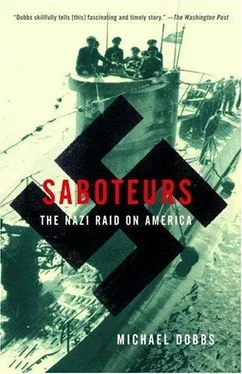Nearby, the engineers pointed out some tall porcelain insulators; a hammer blow to one of these insulators would destroy the vacuum and knock out the power supply. In order to gain access to the porcelain jars, they would probably need to “immobilize” the man in the control room.
Security at the sprawling aluminum plant was hardly perfect, the saboteurs observed with satisfaction. 27Burger and Dasch noted numerous ways of gaining access. The director told them that as an experiment he had instructed his guards to try to smuggle dummy packages of explosives into the plant. Out of twenty-seven men selected for the exercise, twenty-six managed to complete their mission without being caught. In order to strengthen security, the director had appointed guards with shotguns to patrol the exterior and interior of the plant. With his military training, Burger quickly spotted at least one of the guards walking around with an unloaded shotgun over his shoulder, a detail he delighted in pointing out to the director.
Their work completed, the saboteurs and their hosts retired to the company dining room for a feast complete with cigars and bottles of wine. It impressed Dasch as “the swellest dinner I ever had in Germany… We were treated like kings!” 28They spent Thursday night in Bitterfeld, traveling on to Dessau the following morning.
From Dessau, a bus took the party to the brand-new aluminum and magnesium plants at Aachen, which were still being completed. They made the usual inspection tour, but what most struck Dasch and some of the other saboteurs was the system of forced labor recently introduced by Hitler. Ninety percent of the workers at the two plants had been shipped in from conquered areas of the Soviet Union. Many appeared to be starving. Over another lavish lunch, the director explained that these “free” workers—as opposed to prisoners of war—earned around thirty-five marks a week. Out of this amount, they had to pay around thirty marks for food and lodging. In order to buy luxuries, such as beer and cigarettes, they needed special coupons, which were only handed out to the most deserving.
The Russians, Dasch noted, were escorted to and from the camp by armed guard. Even though the weather had turned fairly warm, they came to work dressed in winter clothes, including scraps of old furs. “They wear everything they possess,” one of the German managers explained. “They go to bed with those clothes on and they come to work with them on.” 29He seemed unconcerned that the workers had a tendency to “drop down, just like flies.”
The men returned to Berlin by train that night, arriving at two in the morning. Kappe gave them the rest of the weekend off, telling them to report back on Monday. It had been an exhausting but instructive week.
BEGINNING ON May 18, Kappe called in the men individually to the Rankestrasse bunker to go over final arrangements for their trip. He wanted to make sure that their service papers were all in order before they left for America. Nobody knew what would happen to Kappe and the other Abwehr officers who had ordered the sabotage mission—any of them might be sent to the Russian front at any moment—so it was best to put everything in writing.
Kappe handed each saboteur three documents. 30The first was a financial contract, stipulating the man’s salary and how much his family would receive in the event of his death. It stipulated that the saboteurs would report to the Vertrauensmänner Abteilung, the Trusted Agents’ section of the Abwehr. The second document committed the Abwehr to find an appropriate civilian job for the V-man—as agents were known—once the war was over. The third was a pledge of secrecy, obliging the V-man never to talk about his work to outsiders on penalty of death.
The salary scale depended on the individual saboteur. As group leaders, Dasch and Kerling would receive 600 marks a month. Most of the others would earn from 250 to 500 marks, similar to what they had been making as civilians. The two soldiers, Neubauer and Burger, would continue to receive their regular army pay. Neubauer objected to this arrangement and, after some argument, persuaded Kappe to increase his salary. Burger merely asked for the inclusion of a clause promising him complete rehabilitation in the eyes of the Nazi Party if he carried out his mission successfully. 31The papers had been countersigned in advance by senior Abwehr officers. As Kappe produced each document for signature, he carefully covered up the names of the Abwehr officials. One by one, each V-man signed his name on the dotted line.
From now on, the saboteurs were not permitted to communicate with their families. In order to reassure family members, Kappe made a list of their birthdays. He planned to send each relative birthday greetings from the saboteur announcing that he was alive and well and serving the Fatherland in an undisclosed location. 32If the relatives wanted to reach the saboteur, they could write to Kappe c/o Der Kaukasus.
Next, Kappe made sure his agents were properly clothed for their journey to America. He had been able to scrounge some civilian clothing from a tightly guarded, two-story warehouse on the outskirts of Berlin that contained an array of used clothes, all neatly sorted. Suits and overcoats were on the first floor; hats, underwear, and luggage on the second; shoes down in the cellar. Many of the clothes had foreign labels, from places like Sweden, Czechoslovakia, France, and even America. When Dasch visited the building to help Schmidt pick out a faded blue double-breasted suit and bright yellow shoes, he guessed that the clothes had previously belonged to Jews sent to concentration camps. 33
Some of the men, including Dasch, still had American outfits they had brought back with them to Germany. Kappe told them to make a list of all their belongings so they could wear each other’s clothes. 34Dasch ended up giving away a pair of black shoes, some shirts, and underwear to the other men.
Kappe did not want his agents to wear their civilian clothes when they landed in America. If they were captured, they might be executed as spies. So he took them to a navy warehouse to fit them out in military fatigues, consisting of khaki pants and jacket, wool socks, black boots, and a cap decorated with the swastika. Although none of the uniforms carried any sign of rank or other insignia, Kappe assumed they would be sufficient to identify the men as German soldiers, to be treated as prisoners of war if captured.
Abwehr experts made sure that the V-men had sufficient documentation to support their cover stories in America. They provided them with false ID papers, Social Security cards, and draft registration cards. In Burger’s case, they cleaned up his U.S. naturalization certificate, which showed he had been issued a passport in 1933 to return to Germany. Kappe took the certificate away, returning it a few days later with the incriminating rubber stamp removed. 35
In the meantime, eight wooden crates containing explosives, detonators, and fuses were delivered to the Kaukasus office. 36The boxes—eleven inches wide, eight and a half inches tall, and twenty-one inches long— were all expertly packed. An inner container of galvanized steel made the contents completely waterproof. Six of the boxes, identified with a large X, held yellow blocks of TNT and pieces of exploding coal of the kind the saboteurs had used for training sessions at Quenz Lake. The two other boxes contained various types of detonator, fourteen-day timers, and several dozen “American fountain pen” sets in small leather cases. Each pen concealed an ingenious delay mechanism for setting off explosives: a capsule of sulfuric acid that, once released, would slowly eat its way through a piece of celluloid and ignite a charge of potassium chlorate.
The two group leaders, Dasch and Kerling, needed to settle on a rendezvous point and a system for getting in touch with each other if all else failed. For the meeting place, Kappe suggested Cincinnati. Both group leaders knew the city well, and it was conveniently located between Dasch’s area of operations in the Midwest and Kerling’s in New York State and Pennsylvania. Kappe wanted to give both groups enough time to get across the Atlantic and find their way around America. For the date of their reunion, he proposed July 4, which was both easy to remember and had a patriotic ring to it, appealing to Kappe’s none-too-subtle sense of humor.
Читать дальше












